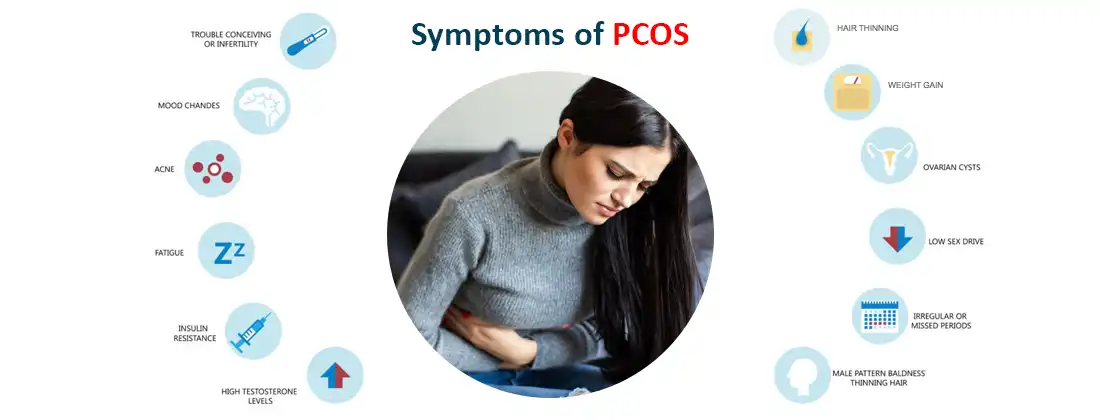
PCOD or PCOS both are the same things. Polycystic Ovary Syndrome (PCOS) stands as one of the most common endocrine disorders affecting women upto 10% globally. This is a hormonal disorder affecting women of reproductive age....
PCOD or PCOS both are the same things. Polycystic Ovary Syndrome (PCOS) stands as one of the most common endocrine disorders affecting women upto 10% globally. This is a hormonal disorder affecting women of reproductive age. Although it usually goes undiagnosed in the starting phase and it shows a variety of symptoms that vary from person to person.
Generally, it is characterized by irregular menstruation, excess androgen levels, and multiple cysts on the ovaries. As irregular menstruation in adolescents is quite common it is difficult to distinguish it from the pubertal changes. Because of increased production of ovarian and adrenal androgen hormone production during puberty may lead to increased acne and mild hirsutism. PCOS in adolescents may increase the risk for developing other disorders like - Infertility in adulthood, obstructive sleep apnea, diabetes, and psychological disorders. Hence, early diagnosis and appropriate management of PCOS are crucial for preventing complications and ensuring a better quality of life for those affected. Ultrasound imaging plays a pivotal role in both diagnosing and managing this syndrome.
What is PCOS/PCOD?
Polycystic Ovarian Disease or PCOD/PCOS also known as Stein- Leventhal Syndrome. Before delving into the role of ultrasound, let's first understand PCOS. It is a common condition of women of reproductive age and this complex condition requires the presence of certain criteria, including irregular menstrual cycles, elevated androgen levels, and polycystic ovaries. Women with PCOS develop cysts on their ovaries and produce an excess amount of androgens. Ultrasound imaging technique is done to check the signs of PCOS.
Patients may need to go for further diagnosis if they have two or more of the symptoms listed below.
Symptoms of PCOS

- Irregular or no periods
- Acne
- Weight gain
- Difficulty in conceiving
- Heavy bleeding during menstruation
- Hair thinning
- Darkening of the skin
- Headache
- Depression
- Symptoms associated with excess clinical androgen excess (e.g. Pimples and excess hair growth)
- Polycystic ovaries which are visible on ultrasound
Tests for PCOS
Doctors may prescribe several tests to diagnose PCOS. The diagnostic tests depend on the individual symptoms
Blood tests for PCOS
Detects the high androgen levels.
Blood tests detect the levels of the reproductive hormone in females that affect the periods like oestrogen ( the female sex hormone) or the FSH/follicle-stimulating hormone.
Blood test results aids to identify the accurate cause and exclude the conditions which show similar symptoms like PCOS.
If any women are planning to go for a PCOS test then they need to stop taking contraceptive pills three months before to check your hormone levels.
It is also advisable in younger females because ultrasound is not recommended for women under 20 years of age.
Ultrasound Test for PCOS

Ultrasound test is a non-invasive diagnostic tests that aids in diagnosing PCOS. Ultrasound produces an image of ovaries what it looks like.
A transvaginal ultrasound is often preferred due to its higher sensitivity in visualising the ovaries compared to an abdominal ultrasound compared to an abdominal ultrasound. This imaging technique helps to identify the characteristic features of PCOS, such as multiple small follicles measuring 2-9mm in diameter arranged peripherally, around an enlarged ovary which is known as “string of pearls” appearance.
What is transvaginal Ultrasound?
A transvaginal ultrasound is a diagnostic test used to look at a woman's uterus, ovaries, cervix, tube and pelvic area.
Before transvaginal ultrasound the patient is asked to drink approx 2L of water to fill the bladder, which makes it easier to evaluate the ovaries.
During the scan a lubricated ultrasound probe is placed inside the vagina then this probe transmits the sound waves and records the reflection of those waves off body structures. The provider will gently move the ultrasound probe around the area to see the pelvic region.
The image is displayed on the computer screen. Then the doctor will interpret the obtained data precisely.
Differential Diagnosis with Ultrasound
Ultrasound not only confirms the presence of multiple cysts on the ovaries, but ultrasound assists in ruling out other conditions that may present similarly to PCOS. Differential diagnosis are- ovarian tumors or other conditions that may cause menstrual irregularities that can be differentiated through ultrasound imaging ensuring accurate diagnosis and subsequent management.
Monitoring and Management
Ultrasound is not only for the diagnosis of PCOS but also aids in managing PCOS. It helps in monitoring the response to treatments and track the follicular development through ultrasound that guides the doctor in adjusting medication dosages to optimize the chances of conception.
Treatment of PCOS

There are several ways to treat and manage PCOS. In case you are overweight then your doctor may recommend losing weight and lifestyle changes. Sometimes doctors may prescribe medicine to treat PCOS. So it is advisable to contact your doctor as soon as possible.
Curing Polycystic Ovarian Disease at Home:
Aloe vera One naturally occurring remedy that can help with PCOS is aloe vera. It aids in ovarian cyst development inhibition and stops new cyst formation. Additionally, it encourages regular menstruation and preserves healthy hormone levels.
Fennel and fenugreek seeds: Fennel and fenugreek have a wealth of medicinal qualities that can be used to treat a variety of illnesses. Fennel seeds aid in preventing ovarian cyst development. Hormone level normalization is aided by fenugreek seeds.
Fish oil capsule: Omega-3 fatty acids are found in fish oil. It lessens hormonal imbalance in the body and aids in the treatment of PCOD.
Therapy for polycystic ovarian disease through medicine
The majority of polycystic ovarian disease treatments are
Lifestyle modifications to avoid PCOD
Eat a balanced diet: Make sure your diet is composed of fresh produce, such as fruits and vegetables. This gives you the right nutrition, quenches your appetite, and lessens your desire for food.
Exercise on a regular basis: Regular exercise keeps you in shape. You are free to select any type of workout. Frequent walking is another beneficial physical activity.
Keep your weight in check: Retaining a healthy weight reduces your chance of developing diabetes and heart disease.
Conclusion
In conclusion, ultrasound stands as a cornerstone in the diagnosis and management of PCOS. Its non-invasive nature, coupled with its ability to visualise ovarian morphology and aid in treatment monitoring, makes it an indispensable tool in the hands of healthcare professionals. However, its interpretation requires skill and experience to ensure accurate diagnosis and effective management for women affected by PCOS.
Polycystic Ovary Syndrome remains a complex and multifaceted condition, and while ultrasound imaging is instrumental, it's just one aspect of a comprehensive approach to diagnosing and managing this condition. Collaborative efforts between healthcare providers, researchers, and patients themselves are essential in navigating PCOS and improving outcomes for those affected.
Why Ganesh Diagnostics?
We have a wide range of diagnostic test like - pathology tests, radio imaging test and nuclear medicine tests. Our diagnostic labs are equipped with highly advanced technology with fully automated machines.









